Capella University BUS-FP3062: Financial Markets and Institutions
VerifiedAdded on 2022/08/22
|6
|967
|22
Homework Assignment
AI Summary
This assignment delves into the core concepts of financial markets and institutions, covering key aspects such as categorizing market transactions as primary or secondary, identifying money market and capital market securities, and recognizing various types of financial institutions. The analysis extends to the factors influencing nominal interest rates, including real risk-free rates, default risk, liquidity risk, and maturity risk, alongside the premium for expected inflation and special provisions for funds. Furthermore, the assignment explores the term structure of interest rates and its representation through the yield curve, discussing the pure expectation theory, liquidity preference theory, and market segmentation theory to explain the relationship between bond yields and maturities. The solution also includes a detailed reference list of academic sources.
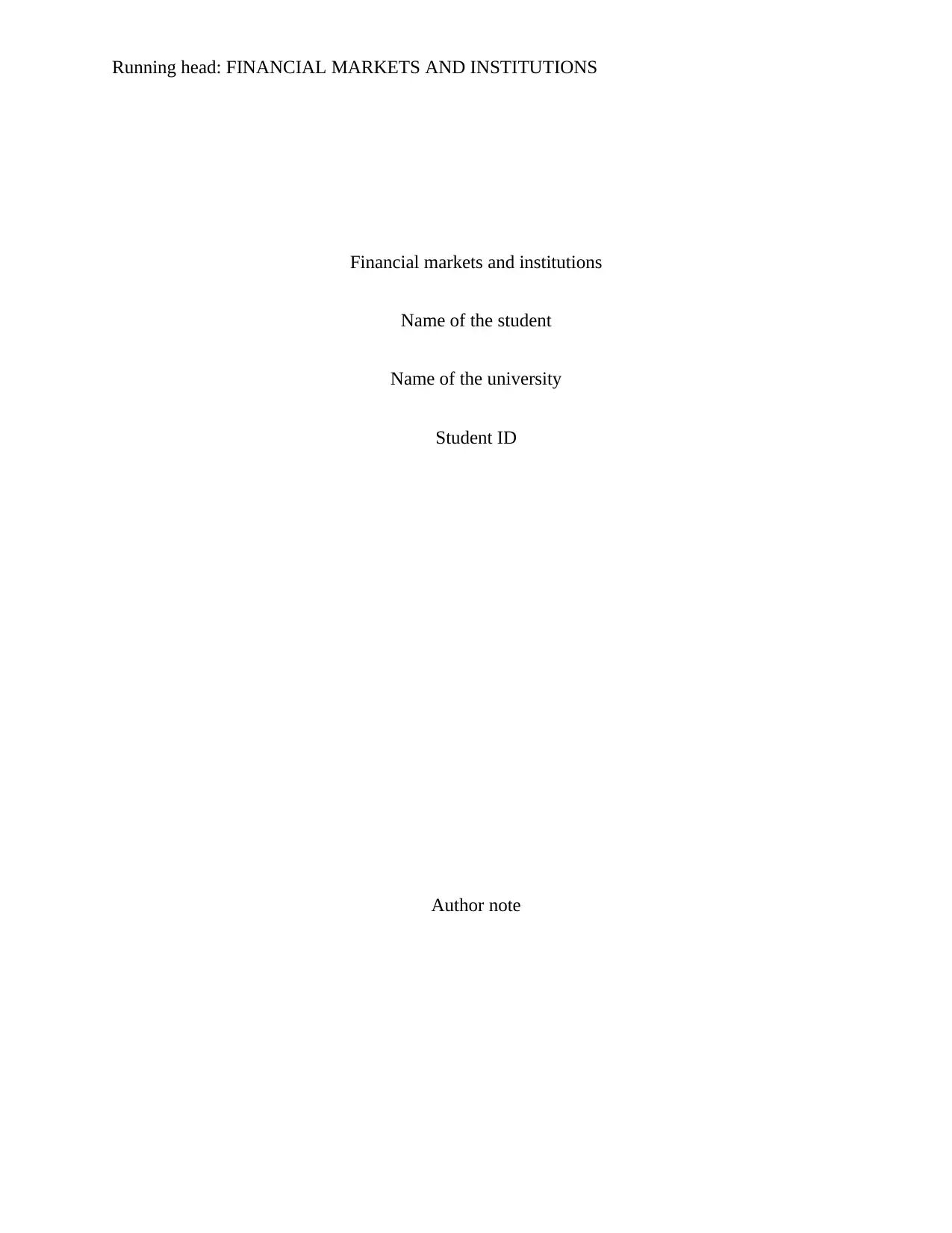
Running head: FINANCIAL MARKETS AND INSTITUTIONS
Financial markets and institutions
Name of the student
Name of the university
Student ID
Author note
Financial markets and institutions
Name of the student
Name of the university
Student ID
Author note
Paraphrase This Document
Need a fresh take? Get an instant paraphrase of this document with our AI Paraphraser
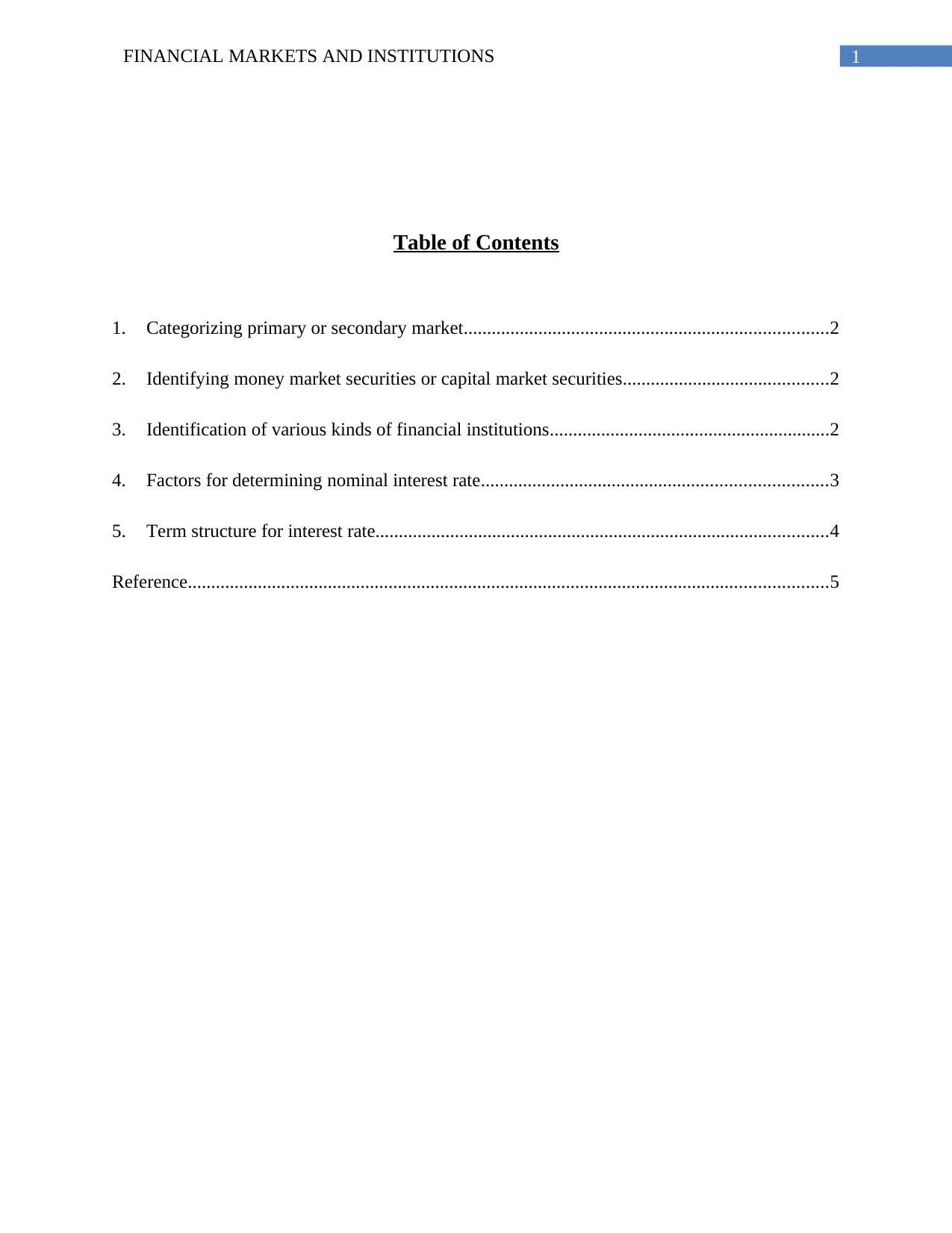
1FINANCIAL MARKETS AND INSTITUTIONS
Table of Contents
1. Categorizing primary or secondary market..............................................................................2
2. Identifying money market securities or capital market securities............................................2
3. Identification of various kinds of financial institutions............................................................2
4. Factors for determining nominal interest rate..........................................................................3
5. Term structure for interest rate.................................................................................................4
Reference.........................................................................................................................................5
Table of Contents
1. Categorizing primary or secondary market..............................................................................2
2. Identifying money market securities or capital market securities............................................2
3. Identification of various kinds of financial institutions............................................................2
4. Factors for determining nominal interest rate..........................................................................3
5. Term structure for interest rate.................................................................................................4
Reference.........................................................................................................................................5
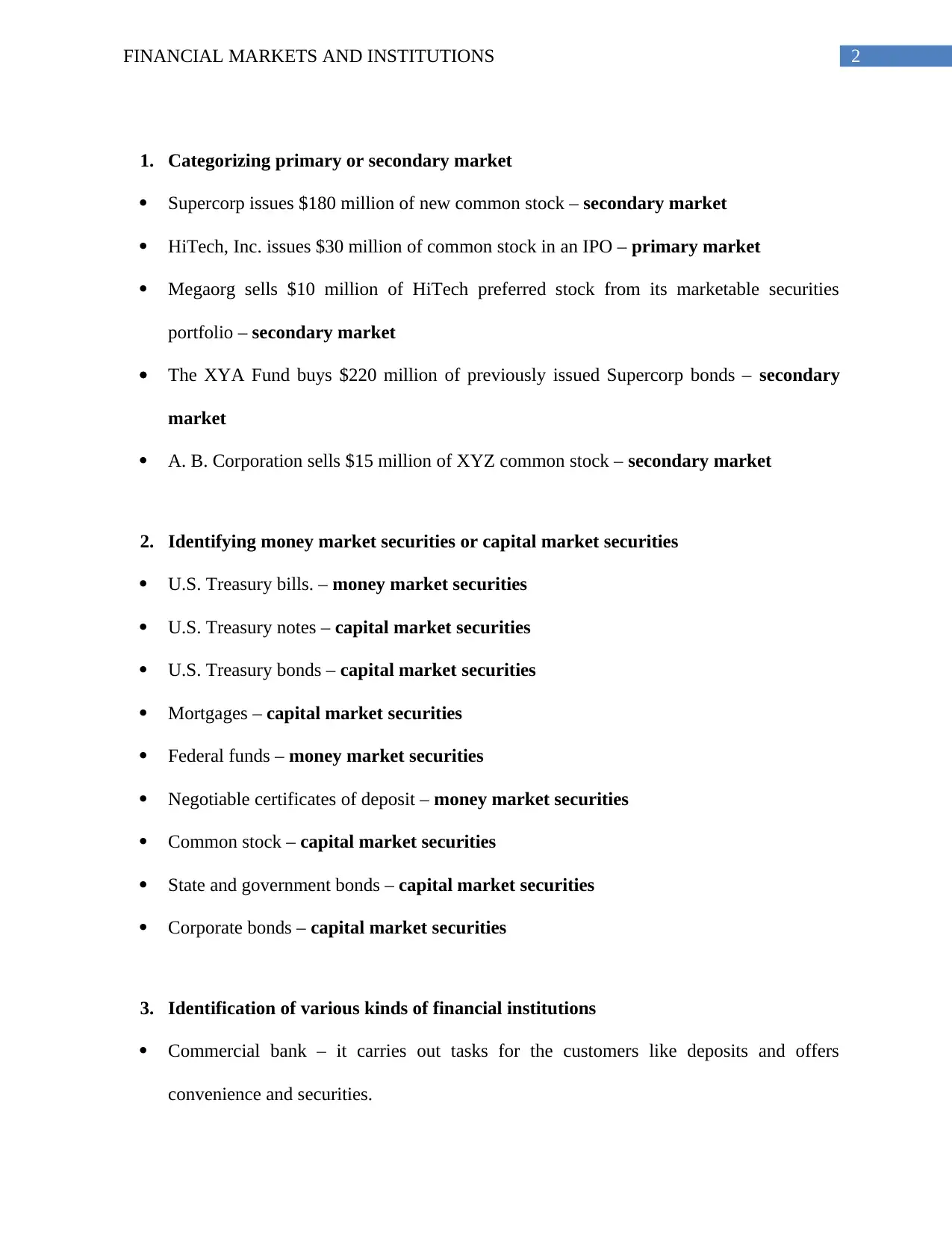
2FINANCIAL MARKETS AND INSTITUTIONS
1. Categorizing primary or secondary market
Supercorp issues $180 million of new common stock – secondary market
HiTech, Inc. issues $30 million of common stock in an IPO – primary market
Megaorg sells $10 million of HiTech preferred stock from its marketable securities
portfolio – secondary market
The XYA Fund buys $220 million of previously issued Supercorp bonds – secondary
market
A. B. Corporation sells $15 million of XYZ common stock – secondary market
2. Identifying money market securities or capital market securities
U.S. Treasury bills. – money market securities
U.S. Treasury notes – capital market securities
U.S. Treasury bonds – capital market securities
Mortgages – capital market securities
Federal funds – money market securities
Negotiable certificates of deposit – money market securities
Common stock – capital market securities
State and government bonds – capital market securities
Corporate bonds – capital market securities
3. Identification of various kinds of financial institutions
Commercial bank – it carries out tasks for the customers like deposits and offers
convenience and securities.
1. Categorizing primary or secondary market
Supercorp issues $180 million of new common stock – secondary market
HiTech, Inc. issues $30 million of common stock in an IPO – primary market
Megaorg sells $10 million of HiTech preferred stock from its marketable securities
portfolio – secondary market
The XYA Fund buys $220 million of previously issued Supercorp bonds – secondary
market
A. B. Corporation sells $15 million of XYZ common stock – secondary market
2. Identifying money market securities or capital market securities
U.S. Treasury bills. – money market securities
U.S. Treasury notes – capital market securities
U.S. Treasury bonds – capital market securities
Mortgages – capital market securities
Federal funds – money market securities
Negotiable certificates of deposit – money market securities
Common stock – capital market securities
State and government bonds – capital market securities
Corporate bonds – capital market securities
3. Identification of various kinds of financial institutions
Commercial bank – it carries out tasks for the customers like deposits and offers
convenience and securities.
⊘ This is a preview!⊘
Do you want full access?
Subscribe today to unlock all pages.

Trusted by 1+ million students worldwide
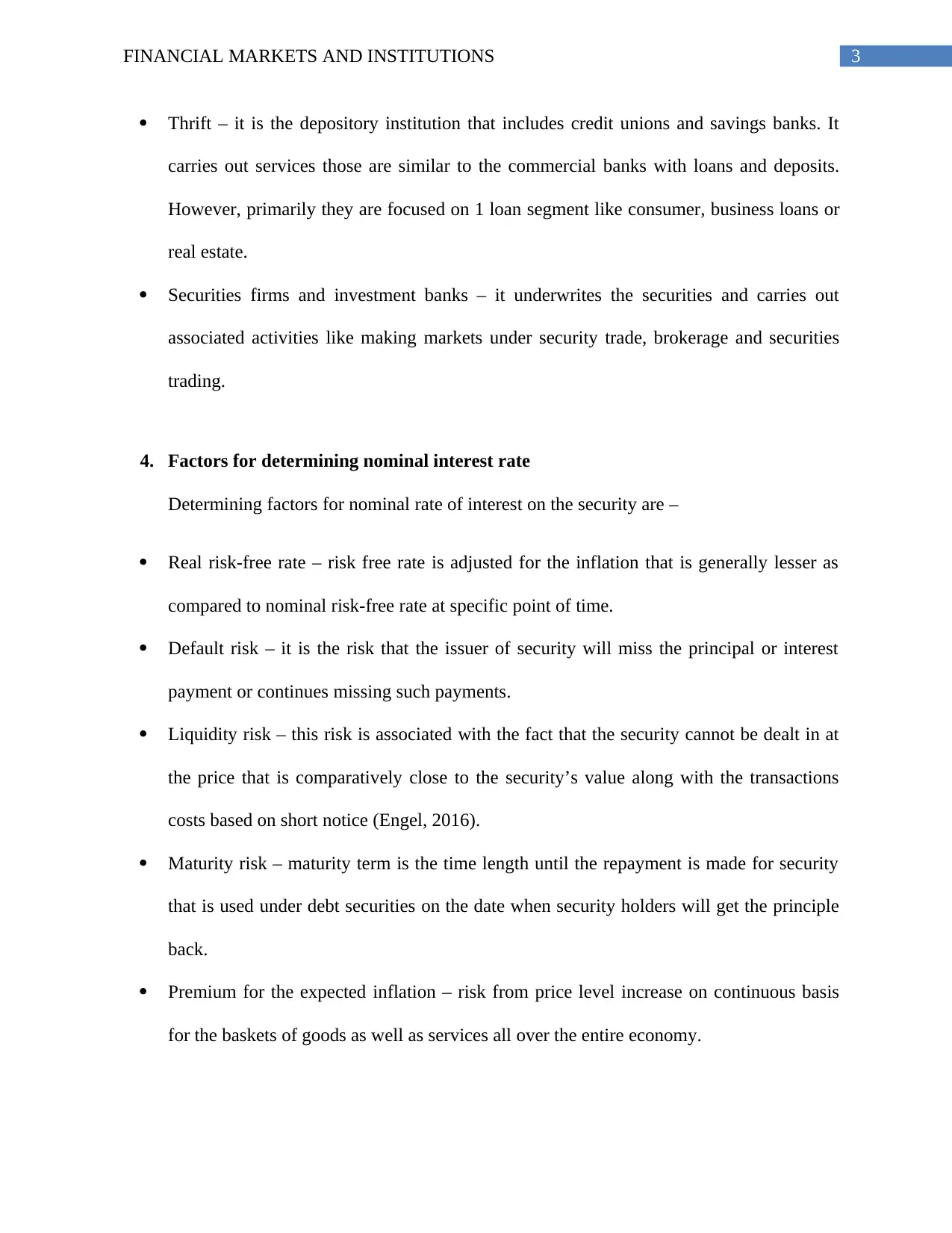
3FINANCIAL MARKETS AND INSTITUTIONS
Thrift – it is the depository institution that includes credit unions and savings banks. It
carries out services those are similar to the commercial banks with loans and deposits.
However, primarily they are focused on 1 loan segment like consumer, business loans or
real estate.
Securities firms and investment banks – it underwrites the securities and carries out
associated activities like making markets under security trade, brokerage and securities
trading.
4. Factors for determining nominal interest rate
Determining factors for nominal rate of interest on the security are –
Real risk-free rate – risk free rate is adjusted for the inflation that is generally lesser as
compared to nominal risk-free rate at specific point of time.
Default risk – it is the risk that the issuer of security will miss the principal or interest
payment or continues missing such payments.
Liquidity risk – this risk is associated with the fact that the security cannot be dealt in at
the price that is comparatively close to the security’s value along with the transactions
costs based on short notice (Engel, 2016).
Maturity risk – maturity term is the time length until the repayment is made for security
that is used under debt securities on the date when security holders will get the principle
back.
Premium for the expected inflation – risk from price level increase on continuous basis
for the baskets of goods as well as services all over the entire economy.
Thrift – it is the depository institution that includes credit unions and savings banks. It
carries out services those are similar to the commercial banks with loans and deposits.
However, primarily they are focused on 1 loan segment like consumer, business loans or
real estate.
Securities firms and investment banks – it underwrites the securities and carries out
associated activities like making markets under security trade, brokerage and securities
trading.
4. Factors for determining nominal interest rate
Determining factors for nominal rate of interest on the security are –
Real risk-free rate – risk free rate is adjusted for the inflation that is generally lesser as
compared to nominal risk-free rate at specific point of time.
Default risk – it is the risk that the issuer of security will miss the principal or interest
payment or continues missing such payments.
Liquidity risk – this risk is associated with the fact that the security cannot be dealt in at
the price that is comparatively close to the security’s value along with the transactions
costs based on short notice (Engel, 2016).
Maturity risk – maturity term is the time length until the repayment is made for security
that is used under debt securities on the date when security holders will get the principle
back.
Premium for the expected inflation – risk from price level increase on continuous basis
for the baskets of goods as well as services all over the entire economy.
Paraphrase This Document
Need a fresh take? Get an instant paraphrase of this document with our AI Paraphraser
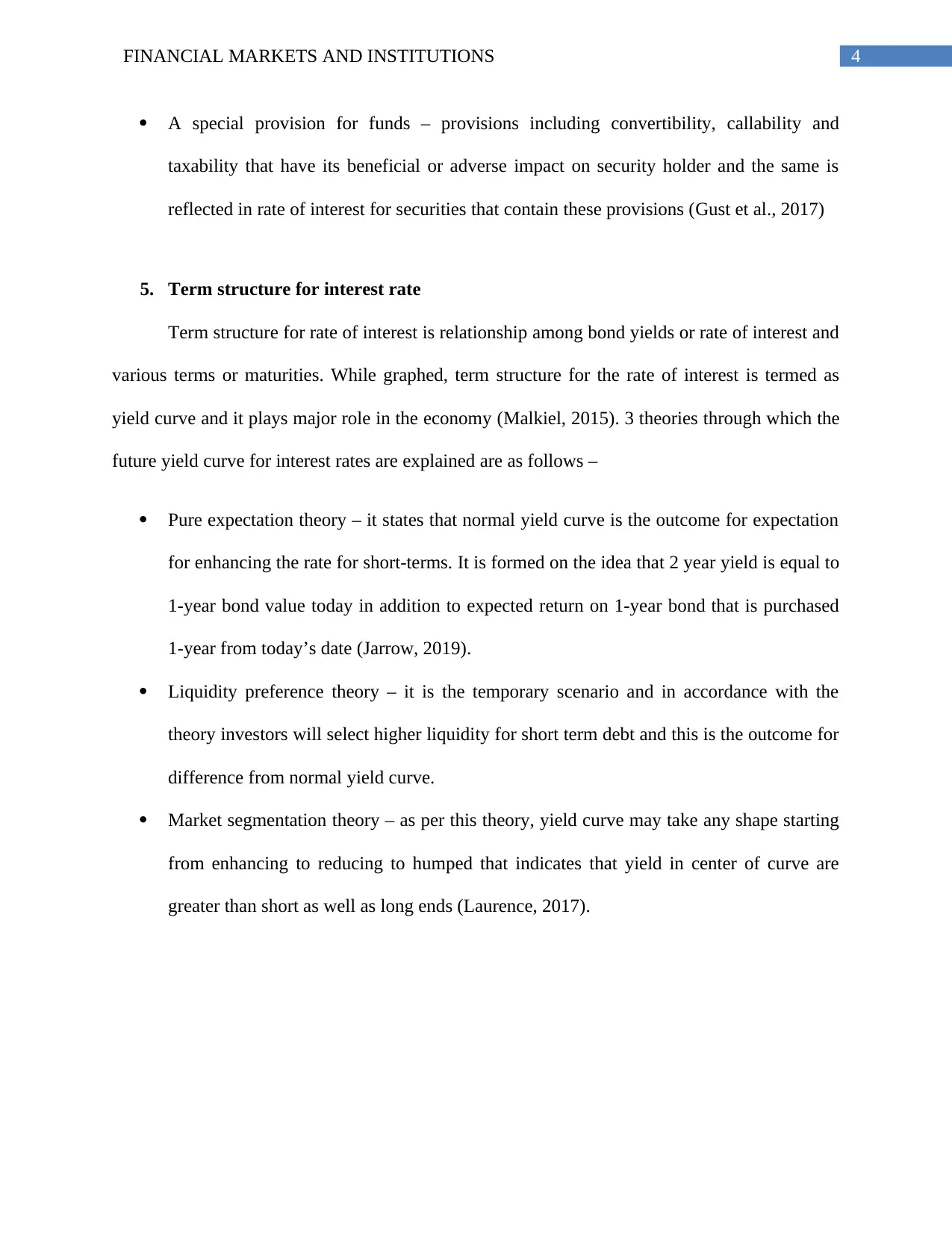
4FINANCIAL MARKETS AND INSTITUTIONS
A special provision for funds – provisions including convertibility, callability and
taxability that have its beneficial or adverse impact on security holder and the same is
reflected in rate of interest for securities that contain these provisions (Gust et al., 2017)
5. Term structure for interest rate
Term structure for rate of interest is relationship among bond yields or rate of interest and
various terms or maturities. While graphed, term structure for the rate of interest is termed as
yield curve and it plays major role in the economy (Malkiel, 2015). 3 theories through which the
future yield curve for interest rates are explained are as follows –
Pure expectation theory – it states that normal yield curve is the outcome for expectation
for enhancing the rate for short-terms. It is formed on the idea that 2 year yield is equal to
1-year bond value today in addition to expected return on 1-year bond that is purchased
1-year from today’s date (Jarrow, 2019).
Liquidity preference theory – it is the temporary scenario and in accordance with the
theory investors will select higher liquidity for short term debt and this is the outcome for
difference from normal yield curve.
Market segmentation theory – as per this theory, yield curve may take any shape starting
from enhancing to reducing to humped that indicates that yield in center of curve are
greater than short as well as long ends (Laurence, 2017).
A special provision for funds – provisions including convertibility, callability and
taxability that have its beneficial or adverse impact on security holder and the same is
reflected in rate of interest for securities that contain these provisions (Gust et al., 2017)
5. Term structure for interest rate
Term structure for rate of interest is relationship among bond yields or rate of interest and
various terms or maturities. While graphed, term structure for the rate of interest is termed as
yield curve and it plays major role in the economy (Malkiel, 2015). 3 theories through which the
future yield curve for interest rates are explained are as follows –
Pure expectation theory – it states that normal yield curve is the outcome for expectation
for enhancing the rate for short-terms. It is formed on the idea that 2 year yield is equal to
1-year bond value today in addition to expected return on 1-year bond that is purchased
1-year from today’s date (Jarrow, 2019).
Liquidity preference theory – it is the temporary scenario and in accordance with the
theory investors will select higher liquidity for short term debt and this is the outcome for
difference from normal yield curve.
Market segmentation theory – as per this theory, yield curve may take any shape starting
from enhancing to reducing to humped that indicates that yield in center of curve are
greater than short as well as long ends (Laurence, 2017).
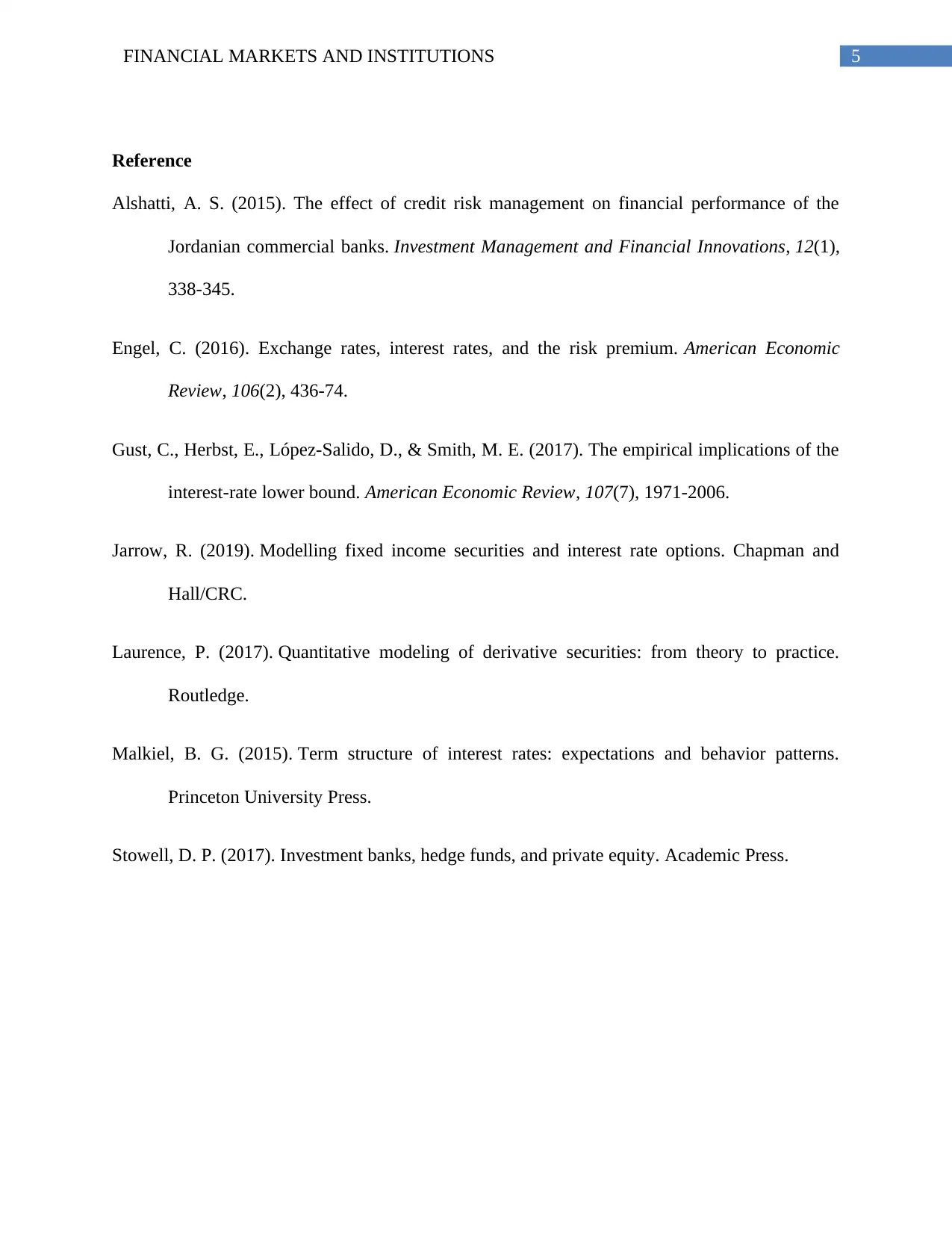
5FINANCIAL MARKETS AND INSTITUTIONS
Reference
Alshatti, A. S. (2015). The effect of credit risk management on financial performance of the
Jordanian commercial banks. Investment Management and Financial Innovations, 12(1),
338-345.
Engel, C. (2016). Exchange rates, interest rates, and the risk premium. American Economic
Review, 106(2), 436-74.
Gust, C., Herbst, E., López-Salido, D., & Smith, M. E. (2017). The empirical implications of the
interest-rate lower bound. American Economic Review, 107(7), 1971-2006.
Jarrow, R. (2019). Modelling fixed income securities and interest rate options. Chapman and
Hall/CRC.
Laurence, P. (2017). Quantitative modeling of derivative securities: from theory to practice.
Routledge.
Malkiel, B. G. (2015). Term structure of interest rates: expectations and behavior patterns.
Princeton University Press.
Stowell, D. P. (2017). Investment banks, hedge funds, and private equity. Academic Press.
Reference
Alshatti, A. S. (2015). The effect of credit risk management on financial performance of the
Jordanian commercial banks. Investment Management and Financial Innovations, 12(1),
338-345.
Engel, C. (2016). Exchange rates, interest rates, and the risk premium. American Economic
Review, 106(2), 436-74.
Gust, C., Herbst, E., López-Salido, D., & Smith, M. E. (2017). The empirical implications of the
interest-rate lower bound. American Economic Review, 107(7), 1971-2006.
Jarrow, R. (2019). Modelling fixed income securities and interest rate options. Chapman and
Hall/CRC.
Laurence, P. (2017). Quantitative modeling of derivative securities: from theory to practice.
Routledge.
Malkiel, B. G. (2015). Term structure of interest rates: expectations and behavior patterns.
Princeton University Press.
Stowell, D. P. (2017). Investment banks, hedge funds, and private equity. Academic Press.
⊘ This is a preview!⊘
Do you want full access?
Subscribe today to unlock all pages.

Trusted by 1+ million students worldwide
1 out of 6
Related Documents
Your All-in-One AI-Powered Toolkit for Academic Success.
+13062052269
info@desklib.com
Available 24*7 on WhatsApp / Email
![[object Object]](/_next/static/media/star-bottom.7253800d.svg)
Unlock your academic potential
Copyright © 2020–2025 A2Z Services. All Rights Reserved. Developed and managed by ZUCOL.





